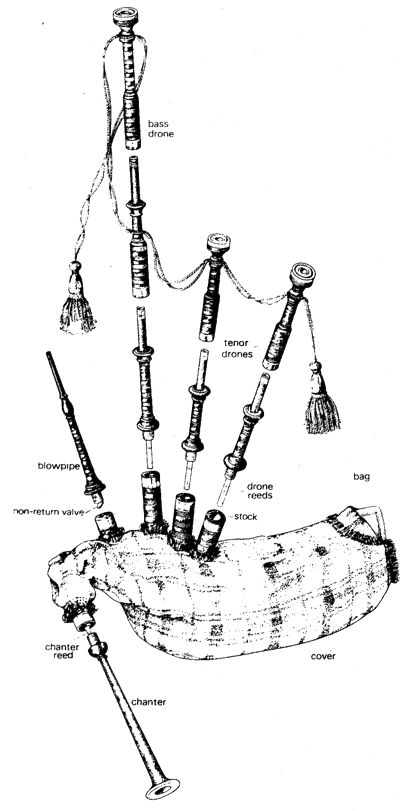The
Sound of the Bagpipes for All Occasions
 How is the sound of a bagpipe made?
How is the sound of a bagpipe made?

There are many versions of the bagpipe around the world, but
the majority of them work the same way as the Scottish Great Highland Bagpipes.
These are the bagpipes that you hear at the Scottish highland games, funerals, or at a St.
Patrick's Day parade. An illustration of the various bagpipe parts is presented
on the right.
The bagpipe is made of an hard wood, like African
Black Wood, a leather bag, and four cane reeds.
Today, new technology is replacing
parts of the bagpipes with synthetic materials that improve the condition and
playing of the instrument. Some of the changes include GORTEX® bags, plastic
drone reeds, and plastic blowpipes with water traps and moisture control mechanisms
inside the bag.
Bagpipes are wind blown reed instruments. They
require a great amount of air and physical endurance to play. The piper plays
the set of pipes by providing air through a blowpipe that extends
from the bag to his mouth. A valve keeps the air from flowing back into his
mouth. By breathing into the blowstick the bag becomes filled to capacity, forcing
air to escape through the drones and through the chanter.
This air pressure makes the four reeds sound simultaneously.
The erie background sound of the pipes is created by the drones when the air is forced over the three reeds. This is one of the distinct capabilities of the bagpipes. The piper will play his or her melody notes on the chanter as the background drones sound continuously.
The chanter reed is a double reed (two blades
of cane tied together) and sounds the melody notes when the piper moves his
fingers over the eight chanter holes. The rest of the air flows over the single
reeds located in the three drones. The taller drone is called the bass and the
two smaller ones are called the tenors. Each drone pipe has a reed in its base.
Bagpipes are tuned by balancing the tone of the three drones (which create the
background humming sound) with the chanter (where the melody notes are played).
When in tune the chanter sounds "bright" without any notes sounding like a cat
being strangled (too sharp or too flat). Neither
the chanter nor the drones should overwhelm each other's sound.
The bagpiper holds the pipes with the bag under his left arm, the
drones resting lightly on his shoulder over the bag, and his left hand fingers
covering the top chanter notes while his right hand covers the lower ones. It
is an uncomfortable position for new players due to the weight of the instrument
(about 8 lbs.) and the need to keep the bag filled and the arm pressure steady
while playing.
Pipers play either standing in one place or walking or marching
as they perform. The piper can perform outside as long as the weather is warm
enough for his fingers. I have performed in 45F degrees on up to 99F degrees.
For more information, please visit this online encyclopedia page on bagpipes.
Another great resource about bagpipes around the world is 
IIntro page
I How the bagpipe sounds I What
to look for I When to use a piper I Weddings
& Funerals I Learning the pipes I Where
to find a piperI
All rights reserved by Thomson
Chew 2009
Please contact me via email at
Thomson C. Chew
Web Site Notes:
Last Update & Software used: August 12, 2009 Dreamweaver 8.0
Printing pages from this site requires setting your page margins to .25"
on all four sides to avoid layout changes on a 8.5"x 11" page with
"portrait" orientation.
The background music is part of Ian Morrison by Fred Morrison (Lismor®
recording The Broken Chanter)